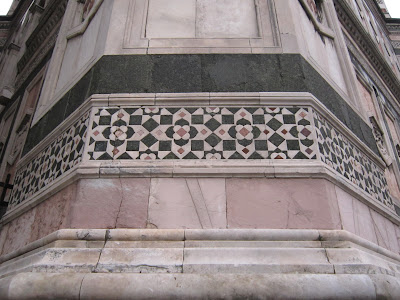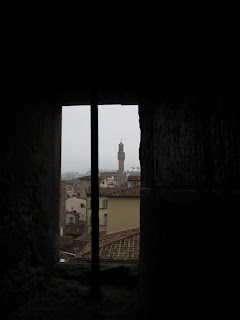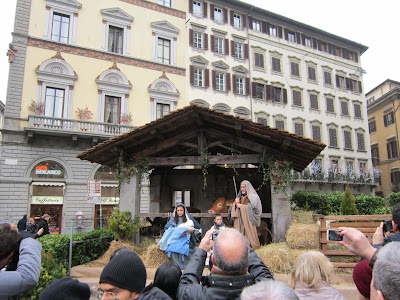By Geoffrey Dean
[Sequel to "Part I: Leaning Tower of Pisa"]
One of my first tasks in Florence was to climb the campanile (bell tower) of the Florence Cathedral (Il Duomo, or Basilica di Santa Maria del Fiore) on the morning of Sunday, January 6 (Epiphany, or La Befana, with the old lady chasing the three wise men on her broom), which in Italy is the climax of their Christmas celebrations. We knew there would be a parade, so we got out into the street around 9 a.m. expecting the festivities to already be in full swing. As it turned out, the street cleaning that we had witnessed the night before was still going on, like this recyclables-collecting truck near Il Duomo,
 |
| The arm lifts the container out of the ground |
 |
| Baptistery and cathedral beyond it to left |
The bell tower was built over a 25-year period in the 14th century, to a design by the painter Giotto. When he died three years into the construction, Andrea Pisano and later Francesco Talenti were appointed his successors in overseeing the progress on both the bell tower and cathedral. Giotto’s design was adhered to with that important exception of the crowning spire, which Talenti did not have built. The spire would have increased the overall height of the tower by almost a third. As it is, the tower is about 85 meters (278 ft) high and has 414 steps to the top. Unlike the leaning tower of Pisa, the bell chamber of Giotto’s tower is enclosed and not accessible to climbing tourists. As if in compensation, the seven bells were rung at regular intervals while I was in the tower, and I distinctly remember the bass tone resonating for at least a minute during each pause in the ringing.
 |
| I was so into the marble designs that I neglected Giotto’s reliefs (barely visible at far left and right) |
 |
| Looking up on side of the tower closest to the cathedral dome, just before entering |
Six “framed” views from different elevations inside the staircase:
 |
| Note the padlocks, which are mentioned later |
The tower’s third and fourth levels are more spacious:
Two views of the baptistery:
Cathedral and baptistery as seen from the roof.
 |
| Notice the mysterious empty flower pots (lower right) |
 |
| Close-up of flower pots |
Views of the cathedral dome, the last part of the cathedral to be completed in the 15th century (the decoration of the façade had to wait until the 19th century; apparently the de Medici family made sure their guy won the dome-design competition, but luckily he also had the know-how to successfully supervise its construction):
Views from the roof:
 |
| Florence panorama looking towards Piazalle Michelangelo, which overlooks Florence from the hills past the south bank of the Arno River |
 |
| The tower’s lightening rod (I’m guessing that’s what it is) as seen from the caged-in walkway around the roof |
 |
| Looking past the baptistery to the San Lorenzo church and the Medici chapel. Past (above) the San Lorenzo dome, follow the diagonal to its vanishing point—that’s the Arno river. |
About an hour later all of the Nativity scene participants were in place, animals sedated, humans in freeze-frame mode, while the organizers smoked at a safe distance. It was a little nippy out there, so I hope “freezing” didn’t have any other significance for these folks!
Uncharacteristically, we stepped into the tourist office located about ten meters from the bell tower and asked about the parade. We learned that it was still several hours off (2:30 p.m.), but our Uffici Gallery reserved entry time intervened, so we missed the sights and only heard some of the sounds from inside.
The next day we visited Arezzo and Siena. Not much to tell except that the made-on-premises pasta in Arezzo was amazing.We had it in this restaurant:
The phrase “local artists” sounds so inappropriate when it’s the Florentine School that you’re talking about, when you realize that their works were already being collected in one place before the Renaissance was over. The Medicis were a family with taste and vision, and I’m okay with its members being glorified in paintings of Botticelli and Carravaggio and so many other Florentine artists displayed in the Uffici. Oh, did I mention the Greek and Roman sculpture corridors on the third floor, where the collection started? Mind-blowing.
On the other side of the Arno we discovered a street lined with one-man ateliers where today’s “local artists” are at work, painting, sculptiing, drafting, and, I imagine, trying to (re)connect in some way to the artistic greats of the past who are so much alive here.
We remained in Florence until early Tuesday morning, having left so much for “next time.” Even in winter, it’s a glorious blast-from-the-past kind of place that deserves much more time for exploration and immersion than we could give it. Did I mention next time? Maybe there will be one.
_______________
Copyright © 2013 by Geoffrey Dean
| Please comment |



















Terrific photos.
ReplyDelete